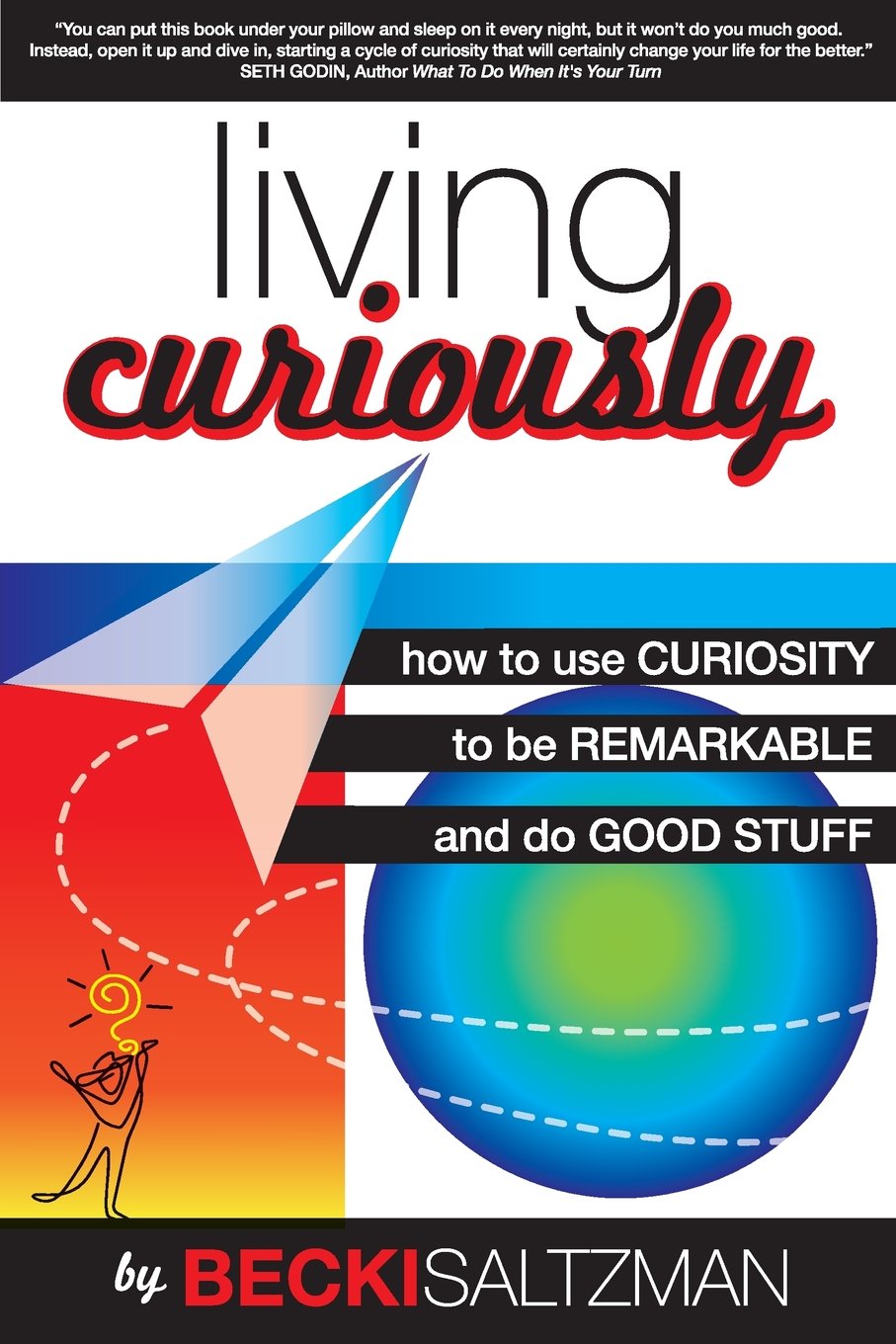Becki Saltzman, author of the incredibly original book Living Curiously: How to Use Curiosity to Be Remarkable and Do Good Stuff, offers up some of the freshest and highly original ideas about how to renovate your attitude and your life.
One of the areas she tackles is the workplace. Here she identifies some of the worst behaviors people exhibit at work, how to avoid them, and what to do to improve the situations.
1. Believing in bogus platitudes. Statements and platitudes like “let’s not reinvent the wheel,” or “good things come to those who wait,” or “the customer is always right,” are often bandied about within organizations. While these can help unite organizations, they can also act as major roadblocks to career advancement. This is especially true if you’re not curious about when they apply and when they don’t.
Instead, test assumptions by facing these platitudes with a healthy dose of skepticism. Explore and test how platitudes relate to things like the review and promotion process, the hiring and firing process, and how your superiors evaluate future leaders.
How to do this: Take an HR specialist out to lunch and ask him or her how the company clichés directly relate to the review and promotion process. Find a relaxing time to ask your boss to share situations when these platitudes have been completely wrong. Ask your co-workers about projects where the results (both good and bad) came as a surprise to everyone, and learn to dissect things that other people miss. Look for a promotion that surprised you, and look for reasons for the promotion that may be different than a “good thing coming to someone who waited.”
2. Clustering in cliques. Joining a clique at work can provide a sense of belonging and security. However, workplace cliques can be career killers when you become branded for your peers and not for yourself. This is particularly dangerous for your career when your clique has fallen out of favor, become part of a huge layoff, or is not being targeted for positions of leadership.
Instead, cross-pollinate and expand your work networks to be broader, rather than deeper. You will be better known across your organization and your industry. Knowing more people and having more people know you will provide more opportunities to step into unforeseen leadership positions. This can also help you navigate group layoffs.
How to do this: Volunteer for causes inside and outside your organization. Host an event at work or in your community where you test a new technology, learn about a new scientific study, or hear an interesting speaker. Once a week, go to lunch with someone from a different department or level in your organization. Identify new people to meet, offer to help a co-worker with a project, or invite them to help you.
3. Trying too hard to be interesting. When you are new to an organization or at times when you feel marginalized at work, making an effort to have your co-workers, customers, and superiors get to know you better seems like a good thing. However, the danger is in the perceived effort. Trying too hard to be seen, heard, and interesting can backfire and make you appear self-centered and desperate.
Instead, focus on being interested. Get more curious about others and, by doing that, they will become more curious about you.
How to do this: Look for sincere and specific reasons to like people. Ask curious questions like, “What would surprise people most about your job?” and “If you could implement one new policy at work, what would it be?” Find something that you like about a co-worker that you like the least. Share your findings with him.
Find uncommon commonalities. Connect with unusual things loved in common and unusual things disliked in common. For example, find something uncommon that you and your boss both enjoy eating. Spicy grasshoppers in mole sauce, anyone? Find something unusual that you and a co-worker both dislike doing outside of work. Interview a co-worker about an unusual work-related project that you both find intriguing.
4. Gravitating toward groupthink. Going along with group agreement or disagreement can make decision-making easier than pioneering original ideas or boldly suggesting different alternatives. However, overly relying on this type of groupthink can reduce your role as a leader and lead to bad decision-making.
Instead, engage in new ways of thinking, and suggest others do the same.
How to do this: Consider as many different potential solutions and options as possible. Consider preposterous ideas. Divergent thinking requires more free-range curiosity, like exploring new ways to use emojis at work. Convergent thinking is when proposed solutions are evaluated for the best possible solution, like figuring out the single best way to use emojis at work for diversity training. Convergent thinking requires more applied curiosity.
Whenever confronted with an A or B choice like “persist or quit” or “do it or don’t do it,” be curious and push yourself and your team to invent 4 additional creative options. Test options that require some things to be done differently. Look at doing some things the same. but by different people, groups, technology, or with more or fewer resources. As you evaluate and assess the new options, engage in divergent and convergent thinking about how and why each option could be best
5. Becoming too familiar. This one is tricky because it is a two-pronged career-killer.
One type of over familiarity is too much sharing. It is wonderful to feel a personal connection to the people at work with whom you spend so much time, but becoming too familiar and too personal can backfire.
The other type of over familiarity is too much “knowing”. It is good to be familiar with what it takes to do your job well, but too much familiarity has dangerous downsides. Over-familiarity is a curiosity-killer that can lead to stagnation. It can also cause you to be blindsided at work. Under familiarity challenges your competence.
Instead, create the Goldilocks level of familiarity of sharing and knowing. Share just the right amount. Allow yourself to be familiar with what you need to know for work, but not too familiar that you stifle your curiosity for learning new things and embracing the unexpected.
How to do this: Find positive ways to connect through shared interests and interesting adventures outside of work, but keep the drama away. Leave the highly personal things about you at home. Wait to take and make dramatic or highly personal phone calls. Do not assume your email is private. Don’t assume that your excellent performance at work will make up for the personal disasters you share. Even if you can hold your liquor, don’t drink so much on business trips or office parties that you could be falsely accused of being drunk.
Try something completely new outside of work, and embrace the feeling of not being an expert. How about a poetry slam? This will get you used to not knowing and you will begin to overcome the fear of being wrong and an over-reliance on too much familiarity. Learn something completely new that has no obvious connection to your job or industry, like the rituals of sumo wrestling. Bring this beginner’s mindset back to work in order to tackle challenging problems with the right amount of familiarity to allow for curiosity.
6. Mental sand traps. Cognitive biases are sneaky mental shortcuts that mislead us as we process information and make decisions and judgments. Biases often help us process information more efficiently. This is good in dangerous situations, but they can also lead us to make career-killing mistakes, where more deliberate thinking and curiosity are required.
Instead, outsmart your biases, go against your gut, and put your intuition to the test.
How to do this: Embrace the uncertainty. Know that the optimism bias makes us all overconfident in our estimates. The more expert we become, the more this bias can ensnare us. When estimating outcomes, combat this by making three specific estimates–high, medium, and low, for example. This helps prevent you from being blindsided by extremes.
To combat the confirmation bias, listen to and consider ideas and information that do not confirm what you believe or wish to be true. If you’re an investor, for example, listen to information that could indicate that you’re overpaying for an investment that you really want to make. Attempt to consider ideas generated by people who you usually dismiss.
7. Behavior bombs. Triggers and biases cause us to behave less than optimally by activating our personal behavior bombs. Your triggers might cause you to erupt when confronted with the selfish behavior of others, the feeling of being falsely accused, not being listened to, feeling a lack of recognition or fairness, or feeling excluded from decision-making.
Instead, be curious about and aware of these triggers before they activate your behavior bombs and cause you to destroy your career. Create a “trigger tool” that will help you elevate curiosity ahead of criticism, judgment, fear, and complacency. This will allow you to assess the trigger before reacting, thereby reducing its power over you.
How to do this: Imagine an electronic dial that you can twist. Use this image to mentally twist to elevate your curiosity so you can instantly start reacting to behavior bomb triggers with curiosity instead of emotion. Ask yourself curious questions like: Can I find one reason that I am ignored, accused, or excluded because of something I do? Can I find one reason to question why I could be wrong about the way I think I’m being treated? Why are these triggers particularly activating for me? Why do I choose to react the way I do? How do other people react to similar triggers in ways that surprise me? Then, surprise others by replacing your behavior bombs with curious questions that turn people into allies, helping you achieve greater performance.
Living Curiously: How to Use Curiosity to be Remarkable and Do Good Stuff
Living Curiously: How to Use Curiosity to Be Remarkable and Do Good Stuff, is the actionable guide and curiosity tool to help you experience things most people never experience, and do the good stuff that will define your remarkability. Create a life of adventure, build a meaningful business and benefit the world.
About Becki Saltzman
Trained in applied psychology at Washington University in St. Louis, as a graduate student Becki Saltzman conducted award-winning research using a mathematical model of behavior prediction. She went on to a career as a fashion buyer, and then spent 20-years as a top real estate broker. All the while she continued to study curiosity and the role it plays in adventure, insights, problem solving, and lifestyle design.
To understand the role of curiosity in the lives of remarkable people, Becki spent two decades studying and collaborating with behavioral scientists, embedding herself into a variety of industries and cultures, and conducting interviews around the world. These findings and adventures provided the ingredients for the Living Curiously Method–a 5-step method for using curiosity to be remarkable and do good stuff
Becki is the author of Living Curiously: How to Use Curiosity to Be Remarkable and Do Good Stuff, and Arousing the Buy Curious: Real Estate Pillow Talk for Patrons and Professionals. Her blog, Living Curiously, is an exercise apparatus for flexing curiosity muscles (so they don’t atrophy).
She lives in Portland, Oregon.
Find a Home-Based Business to Start-Up >>> Hundreds of Business Listings.



















































